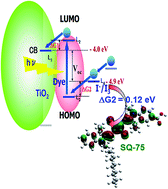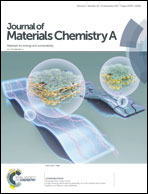Investigation of the minimum driving force for dye regeneration utilizing model squaraine dyes for dye-sensitized solar cells
Abstract
Combined theoretical and experimental approaches were implemented to design model far-red sensitive unsymmetrical squaraine dyes in order to estimate the minimum energy barrier required for dye regeneration. Our logical molecular design indicated that it is possible to have a fine control on the energetics within 0.2 eV only by the judicious selection of substituents and alkyl chain length keeping the main π-molecular framework the same. The utilization of the LSDA functional under TD-DFT calculations offered an effective and economical computational method for the reliable prediction of the energetics as well as the absorption maximum of the sensitizers. Among the designed dyes under investigation, SQ-75 exhibited the best photovoltaic performance, having a short-circuit current density of 10.92 mA cm−2, open circuit voltage of 0.57 V and a fill factor of 0.67, leading to a photoconversion efficiency of 4.25% despite having photon harvesting mainly in the far-red region. The best photon harvesting by SQ-75, even with an energy difference of only 0.12 eV between the energy of its highest occupied molecular orbital and redox energy level I−/I3− electrolyte, corroborates the possibility for dye regeneration with such a small driving force.



 Please wait while we load your content...
Please wait while we load your content...